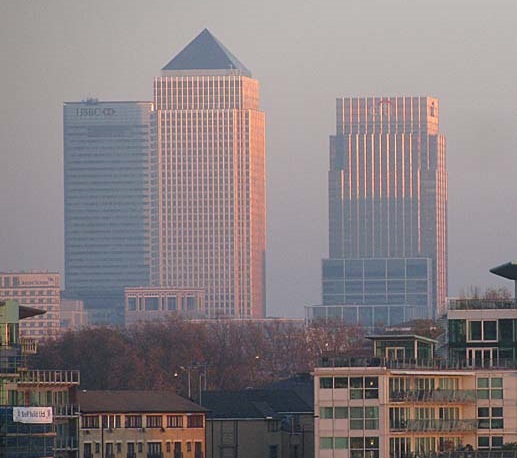One Canada Square
One Canada Square, commonly referred to as Canary Wharf Tower, is a skyscraper located in the London’s Docklands area known as Canary Wharf. With a height of 235 m (770 ft), it is currently (2018) the second tallest building in the United Kingdom. It is predominantly used for offices, although there are a number of retail units on the lower ground floor.
Designed by Cesar Pelli, Adamson Associates and Frederick Gibberd Coombes in the postmodern style, the building takes the form of an obelisk; a tower that is square in plan and topped with a pyramid.
Construction began in 1988, and upon completion in 1991 it was the tallest building in Europe and remained the UK’s tallest building for 20 years, helping to transform the previously derelict Isle of Dogs into a successful financial district.
The developers originally intended to clad the 50-storey tower in stone, but this was later changed to low density aluminium, before settling on stainless steel with a linen finish. It was the first skyscraper to have been constructed with stainless steel. In total, approximately 27,500 tonnes of British steel were used.
The construction involved building a large cofferdam to prevent water leakage into the site, and 222 piles were driven into the ground to depths of 23 m. A 4 m-thick concrete raft was sunk into the ground to act as an anchor.
The core of the building includes a tuned mass damper – a steel pendulum – that sways to offset movements caused by strong winds.
The stainless steel pyramidal roof, measuring 30 sq. m at its base, encloses maintenance plant and other facilities for water supply, as well as a warning beacon for aircraft travelling to and from the nearby London City Airport.
The building is regularly used on TV and for films, making it one of the most recognisable buildings in the UK.
[edit] Related articles on Designing Buildings Wiki
Featured articles and news
RTPI leader to become new CIOB Chief Executive Officer
Dr Victoria Hills MRTPI, FICE to take over after Caroline Gumble’s departure.
Social and affordable housing, a long term plan for delivery
The “Delivering a Decade of Renewal for Social and Affordable Housing” strategy sets out future path.
A change to adoptive architecture
Effects of global weather warming on architectural detailing, material choice and human interaction.
The proposed publicly owned and backed subsidiary of Homes England, to facilitate new homes.
How big is the problem and what can we do to mitigate the effects?
Overheating guidance and tools for building designers
A number of cool guides to help with the heat.
The UK's Modern Industrial Strategy: A 10 year plan
Previous consultation criticism, current key elements and general support with some persisting reservations.
Building Safety Regulator reforms
New roles, new staff and a new fast track service pave the way for a single construction regulator.
Architectural Technologist CPDs and Communications
CIAT CPD… and how you can do it!
Cooling centres and cool spaces
Managing extreme heat in cities by directing the public to places for heat stress relief and water sources.
Winter gardens: A brief history and warm variations
Extending the season with glass in different forms and terms.
Restoring Great Yarmouth's Winter Gardens
Transforming one of the least sustainable constructions imaginable.
Construction Skills Mission Board launch sector drive
Newly formed government and industry collaboration set strategy for recruiting an additional 100,000 construction workers a year.
New Architects Code comes into effect in September 2025
ARB Architects Code of Conduct and Practice available with ongoing consultation regarding guidance.
Welsh Skills Body (Medr) launches ambitious plan
The new skills body brings together funding and regulation of tertiary education and research for the devolved nation.
Paul Gandy FCIOB announced as next CIOB President
Former Tilbury Douglas CEO takes helm.
UK Infrastructure: A 10 Year Strategy. In brief with reactions
With the National Infrastructure and Service Transformation Authority (NISTA).























